The Psychology of Health and Wellness: Factors, Responses, and More
VerifiedAdded on 2023/06/01
|7
|1766
|182
Essay
AI Summary
This essay delves into the psychology of health and wellness, defining health and wellness, and exploring the health continuum. It examines the biopsychosocial factors that influence health, including biological, psychological, and social conditions. The essay discusses the impact of trauma, depression, and social influences like culture and socioeconomic status on health outcomes. It further analyzes behavioral and cognitive responses to maintain health, such as exercise and health beliefs. The essay also highlights the importance of education, health services, and lifestyle choices in promoting overall well-being, referencing various studies and perspectives to support its arguments.
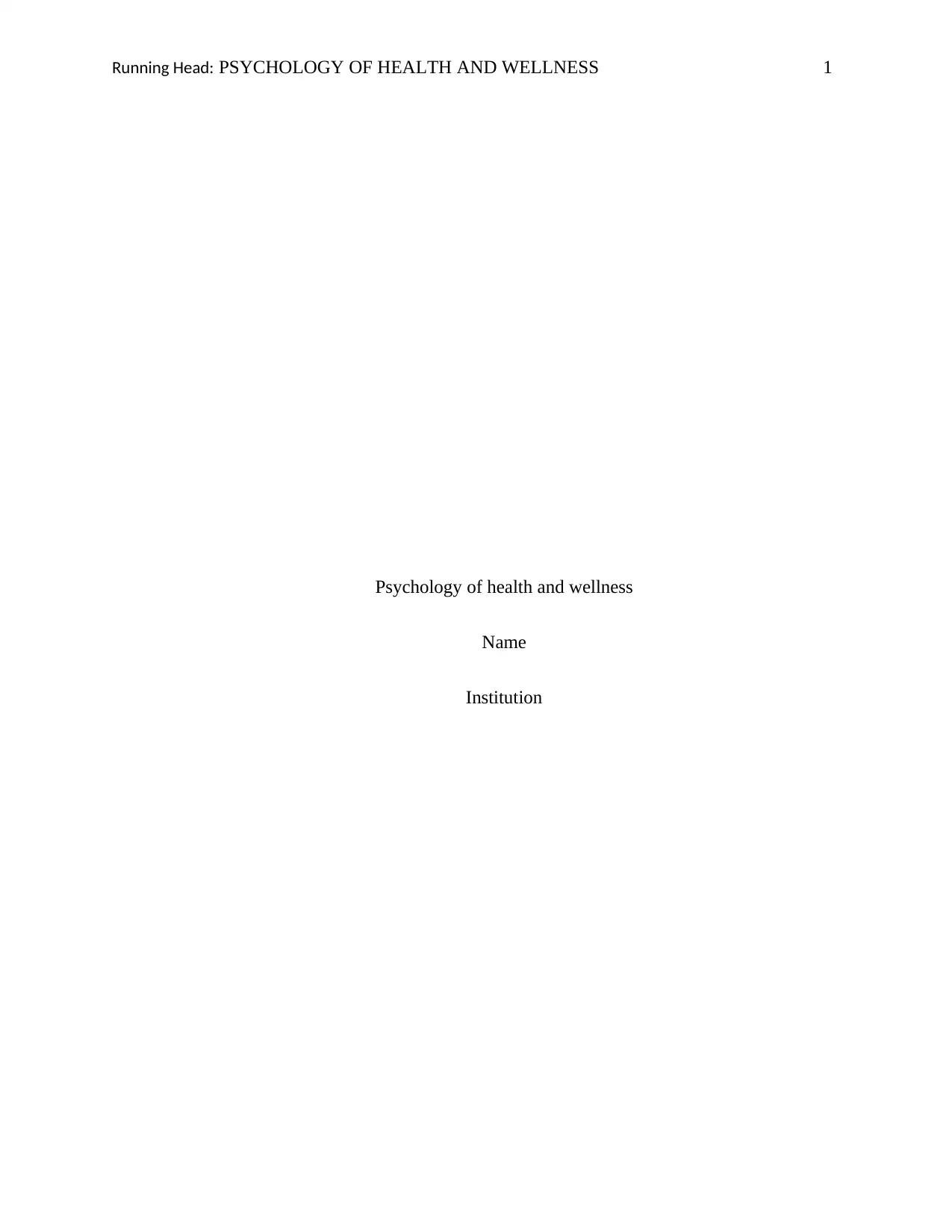
Running Head: PSYCHOLOGY OF HEALTH AND WELLNESS 1
Psychology of health and wellness
Name
Institution
Psychology of health and wellness
Name
Institution
Paraphrase This Document
Need a fresh take? Get an instant paraphrase of this document with our AI Paraphraser
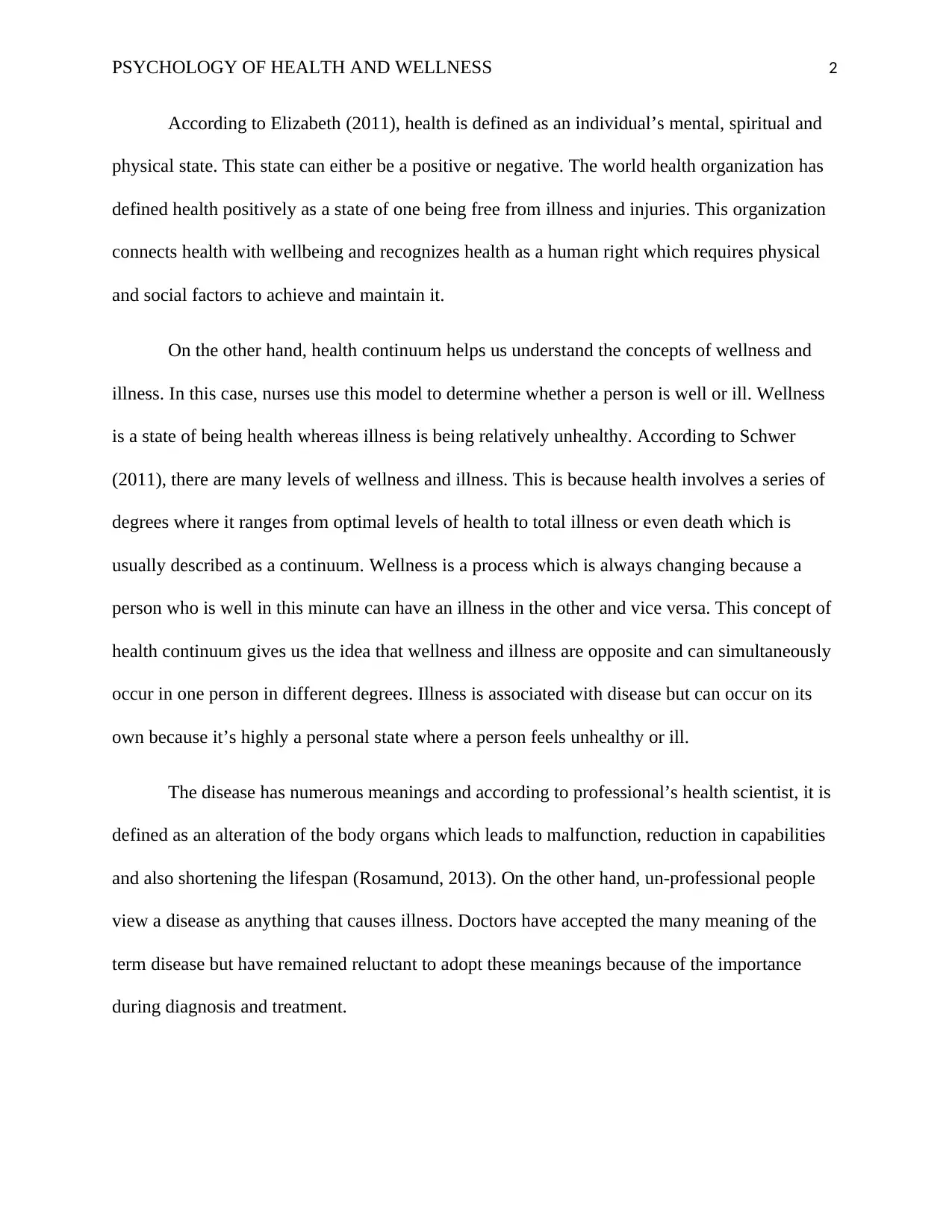
PSYCHOLOGY OF HEALTH AND WELLNESS 2
According to Elizabeth (2011), health is defined as an individual’s mental, spiritual and
physical state. This state can either be a positive or negative. The world health organization has
defined health positively as a state of one being free from illness and injuries. This organization
connects health with wellbeing and recognizes health as a human right which requires physical
and social factors to achieve and maintain it.
On the other hand, health continuum helps us understand the concepts of wellness and
illness. In this case, nurses use this model to determine whether a person is well or ill. Wellness
is a state of being health whereas illness is being relatively unhealthy. According to Schwer
(2011), there are many levels of wellness and illness. This is because health involves a series of
degrees where it ranges from optimal levels of health to total illness or even death which is
usually described as a continuum. Wellness is a process which is always changing because a
person who is well in this minute can have an illness in the other and vice versa. This concept of
health continuum gives us the idea that wellness and illness are opposite and can simultaneously
occur in one person in different degrees. Illness is associated with disease but can occur on its
own because it’s highly a personal state where a person feels unhealthy or ill.
The disease has numerous meanings and according to professional’s health scientist, it is
defined as an alteration of the body organs which leads to malfunction, reduction in capabilities
and also shortening the lifespan (Rosamund, 2013). On the other hand, un-professional people
view a disease as anything that causes illness. Doctors have accepted the many meaning of the
term disease but have remained reluctant to adopt these meanings because of the importance
during diagnosis and treatment.
According to Elizabeth (2011), health is defined as an individual’s mental, spiritual and
physical state. This state can either be a positive or negative. The world health organization has
defined health positively as a state of one being free from illness and injuries. This organization
connects health with wellbeing and recognizes health as a human right which requires physical
and social factors to achieve and maintain it.
On the other hand, health continuum helps us understand the concepts of wellness and
illness. In this case, nurses use this model to determine whether a person is well or ill. Wellness
is a state of being health whereas illness is being relatively unhealthy. According to Schwer
(2011), there are many levels of wellness and illness. This is because health involves a series of
degrees where it ranges from optimal levels of health to total illness or even death which is
usually described as a continuum. Wellness is a process which is always changing because a
person who is well in this minute can have an illness in the other and vice versa. This concept of
health continuum gives us the idea that wellness and illness are opposite and can simultaneously
occur in one person in different degrees. Illness is associated with disease but can occur on its
own because it’s highly a personal state where a person feels unhealthy or ill.
The disease has numerous meanings and according to professional’s health scientist, it is
defined as an alteration of the body organs which leads to malfunction, reduction in capabilities
and also shortening the lifespan (Rosamund, 2013). On the other hand, un-professional people
view a disease as anything that causes illness. Doctors have accepted the many meaning of the
term disease but have remained reluctant to adopt these meanings because of the importance
during diagnosis and treatment.
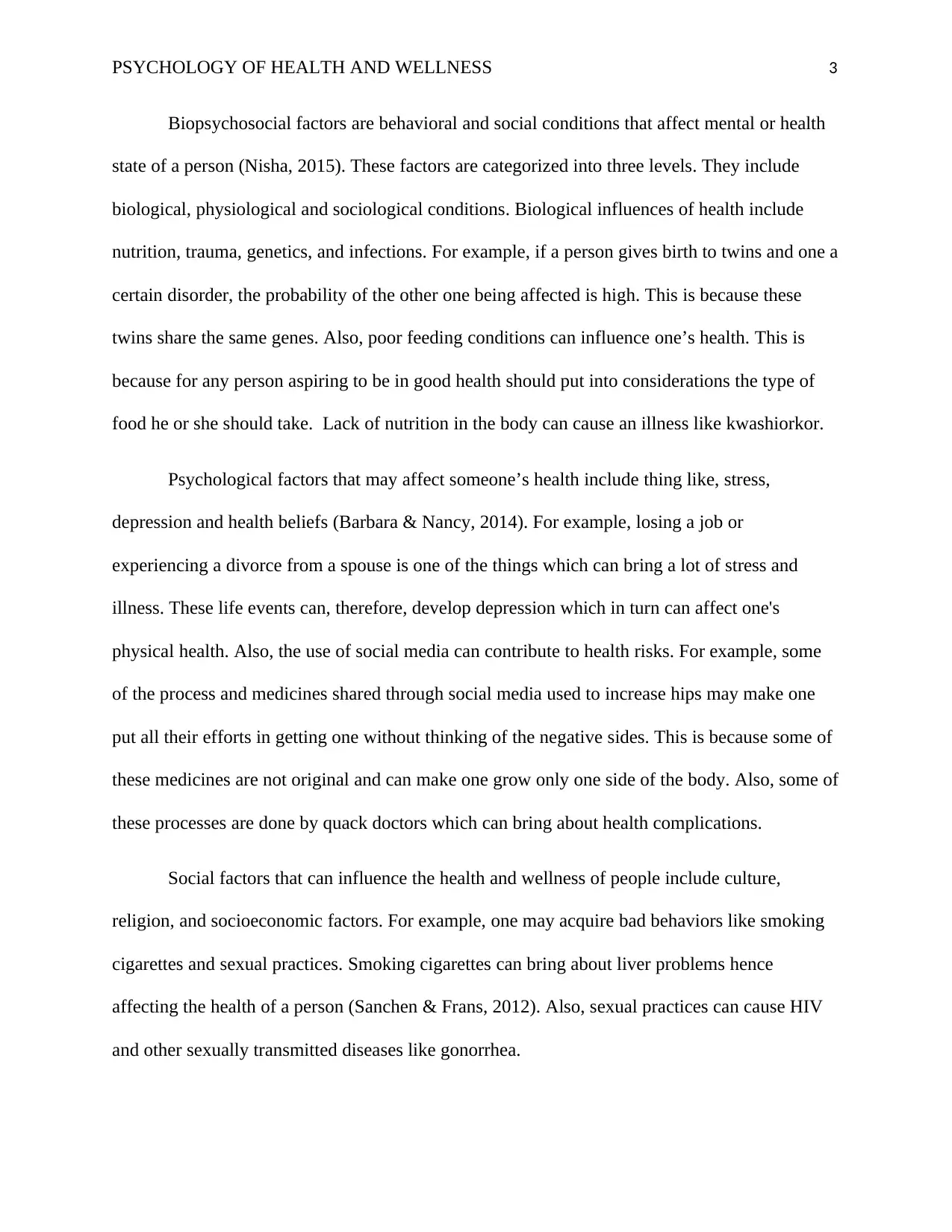
PSYCHOLOGY OF HEALTH AND WELLNESS 3
Biopsychosocial factors are behavioral and social conditions that affect mental or health
state of a person (Nisha, 2015). These factors are categorized into three levels. They include
biological, physiological and sociological conditions. Biological influences of health include
nutrition, trauma, genetics, and infections. For example, if a person gives birth to twins and one a
certain disorder, the probability of the other one being affected is high. This is because these
twins share the same genes. Also, poor feeding conditions can influence one’s health. This is
because for any person aspiring to be in good health should put into considerations the type of
food he or she should take. Lack of nutrition in the body can cause an illness like kwashiorkor.
Psychological factors that may affect someone’s health include thing like, stress,
depression and health beliefs (Barbara & Nancy, 2014). For example, losing a job or
experiencing a divorce from a spouse is one of the things which can bring a lot of stress and
illness. These life events can, therefore, develop depression which in turn can affect one's
physical health. Also, the use of social media can contribute to health risks. For example, some
of the process and medicines shared through social media used to increase hips may make one
put all their efforts in getting one without thinking of the negative sides. This is because some of
these medicines are not original and can make one grow only one side of the body. Also, some of
these processes are done by quack doctors which can bring about health complications.
Social factors that can influence the health and wellness of people include culture,
religion, and socioeconomic factors. For example, one may acquire bad behaviors like smoking
cigarettes and sexual practices. Smoking cigarettes can bring about liver problems hence
affecting the health of a person (Sanchen & Frans, 2012). Also, sexual practices can cause HIV
and other sexually transmitted diseases like gonorrhea.
Biopsychosocial factors are behavioral and social conditions that affect mental or health
state of a person (Nisha, 2015). These factors are categorized into three levels. They include
biological, physiological and sociological conditions. Biological influences of health include
nutrition, trauma, genetics, and infections. For example, if a person gives birth to twins and one a
certain disorder, the probability of the other one being affected is high. This is because these
twins share the same genes. Also, poor feeding conditions can influence one’s health. This is
because for any person aspiring to be in good health should put into considerations the type of
food he or she should take. Lack of nutrition in the body can cause an illness like kwashiorkor.
Psychological factors that may affect someone’s health include thing like, stress,
depression and health beliefs (Barbara & Nancy, 2014). For example, losing a job or
experiencing a divorce from a spouse is one of the things which can bring a lot of stress and
illness. These life events can, therefore, develop depression which in turn can affect one's
physical health. Also, the use of social media can contribute to health risks. For example, some
of the process and medicines shared through social media used to increase hips may make one
put all their efforts in getting one without thinking of the negative sides. This is because some of
these medicines are not original and can make one grow only one side of the body. Also, some of
these processes are done by quack doctors which can bring about health complications.
Social factors that can influence the health and wellness of people include culture,
religion, and socioeconomic factors. For example, one may acquire bad behaviors like smoking
cigarettes and sexual practices. Smoking cigarettes can bring about liver problems hence
affecting the health of a person (Sanchen & Frans, 2012). Also, sexual practices can cause HIV
and other sexually transmitted diseases like gonorrhea.
⊘ This is a preview!⊘
Do you want full access?
Subscribe today to unlock all pages.

Trusted by 1+ million students worldwide
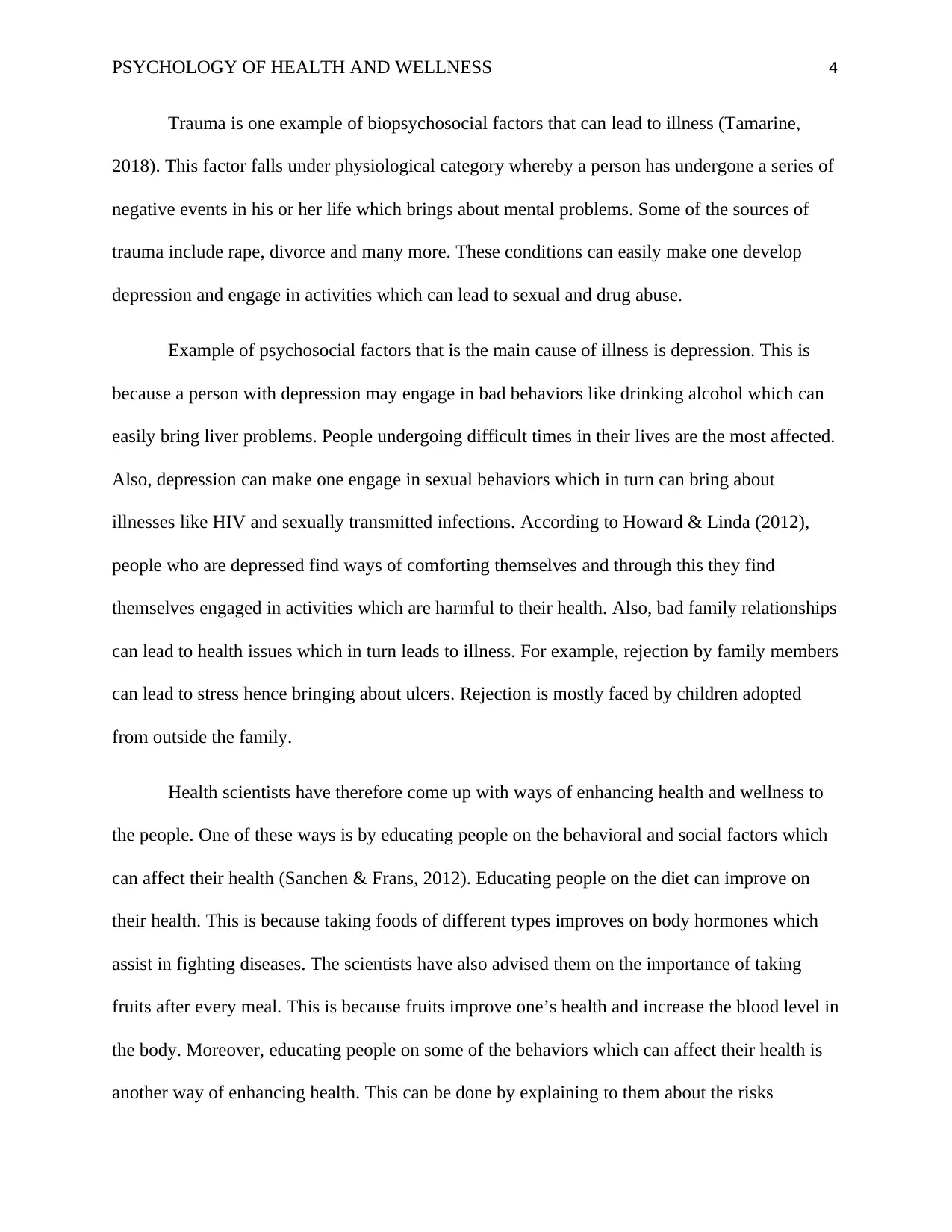
PSYCHOLOGY OF HEALTH AND WELLNESS 4
Trauma is one example of biopsychosocial factors that can lead to illness (Tamarine,
2018). This factor falls under physiological category whereby a person has undergone a series of
negative events in his or her life which brings about mental problems. Some of the sources of
trauma include rape, divorce and many more. These conditions can easily make one develop
depression and engage in activities which can lead to sexual and drug abuse.
Example of psychosocial factors that is the main cause of illness is depression. This is
because a person with depression may engage in bad behaviors like drinking alcohol which can
easily bring liver problems. People undergoing difficult times in their lives are the most affected.
Also, depression can make one engage in sexual behaviors which in turn can bring about
illnesses like HIV and sexually transmitted infections. According to Howard & Linda (2012),
people who are depressed find ways of comforting themselves and through this they find
themselves engaged in activities which are harmful to their health. Also, bad family relationships
can lead to health issues which in turn leads to illness. For example, rejection by family members
can lead to stress hence bringing about ulcers. Rejection is mostly faced by children adopted
from outside the family.
Health scientists have therefore come up with ways of enhancing health and wellness to
the people. One of these ways is by educating people on the behavioral and social factors which
can affect their health (Sanchen & Frans, 2012). Educating people on the diet can improve on
their health. This is because taking foods of different types improves on body hormones which
assist in fighting diseases. The scientists have also advised them on the importance of taking
fruits after every meal. This is because fruits improve one’s health and increase the blood level in
the body. Moreover, educating people on some of the behaviors which can affect their health is
another way of enhancing health. This can be done by explaining to them about the risks
Trauma is one example of biopsychosocial factors that can lead to illness (Tamarine,
2018). This factor falls under physiological category whereby a person has undergone a series of
negative events in his or her life which brings about mental problems. Some of the sources of
trauma include rape, divorce and many more. These conditions can easily make one develop
depression and engage in activities which can lead to sexual and drug abuse.
Example of psychosocial factors that is the main cause of illness is depression. This is
because a person with depression may engage in bad behaviors like drinking alcohol which can
easily bring liver problems. People undergoing difficult times in their lives are the most affected.
Also, depression can make one engage in sexual behaviors which in turn can bring about
illnesses like HIV and sexually transmitted infections. According to Howard & Linda (2012),
people who are depressed find ways of comforting themselves and through this they find
themselves engaged in activities which are harmful to their health. Also, bad family relationships
can lead to health issues which in turn leads to illness. For example, rejection by family members
can lead to stress hence bringing about ulcers. Rejection is mostly faced by children adopted
from outside the family.
Health scientists have therefore come up with ways of enhancing health and wellness to
the people. One of these ways is by educating people on the behavioral and social factors which
can affect their health (Sanchen & Frans, 2012). Educating people on the diet can improve on
their health. This is because taking foods of different types improves on body hormones which
assist in fighting diseases. The scientists have also advised them on the importance of taking
fruits after every meal. This is because fruits improve one’s health and increase the blood level in
the body. Moreover, educating people on some of the behaviors which can affect their health is
another way of enhancing health. This can be done by explaining to them about the risks
Paraphrase This Document
Need a fresh take? Get an instant paraphrase of this document with our AI Paraphraser
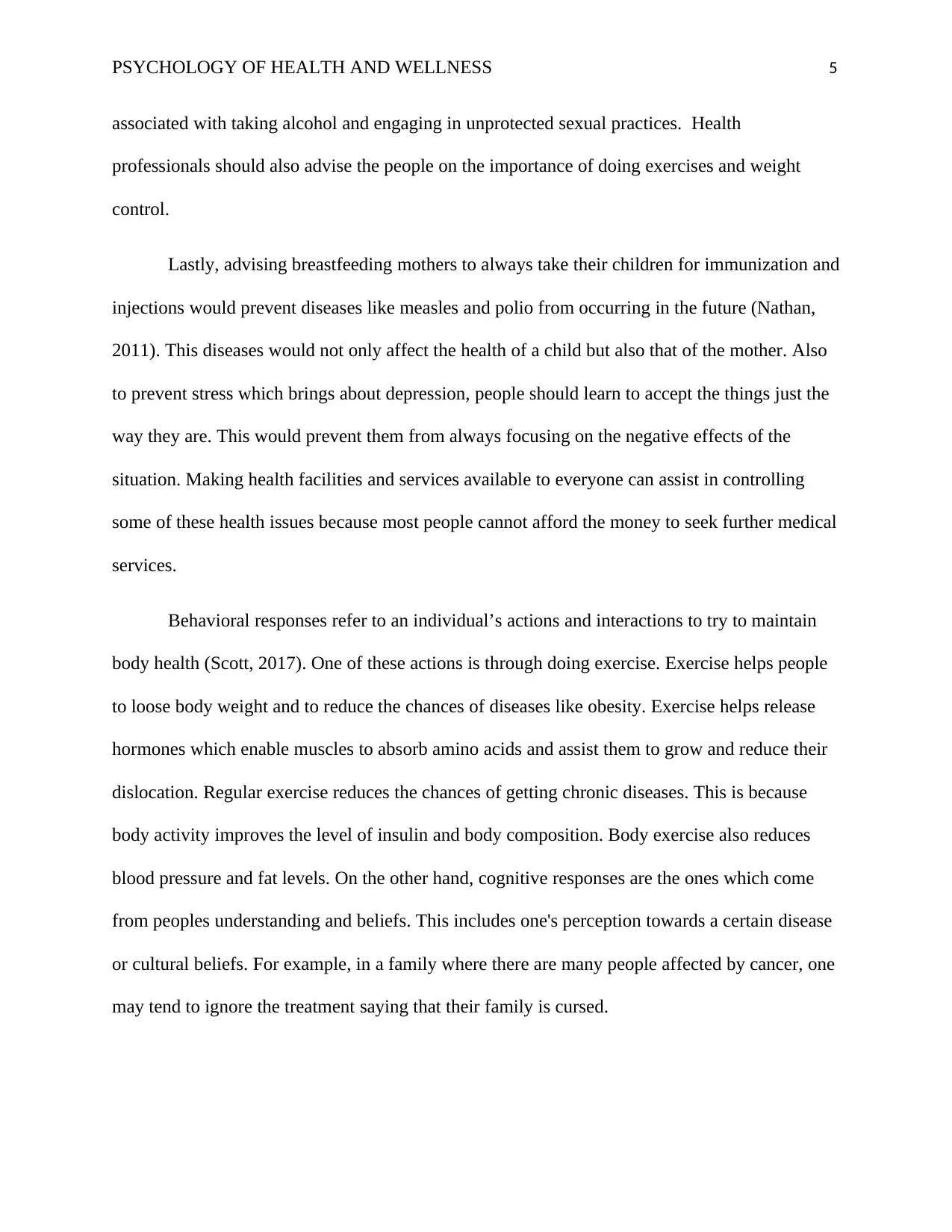
PSYCHOLOGY OF HEALTH AND WELLNESS 5
associated with taking alcohol and engaging in unprotected sexual practices. Health
professionals should also advise the people on the importance of doing exercises and weight
control.
Lastly, advising breastfeeding mothers to always take their children for immunization and
injections would prevent diseases like measles and polio from occurring in the future (Nathan,
2011). This diseases would not only affect the health of a child but also that of the mother. Also
to prevent stress which brings about depression, people should learn to accept the things just the
way they are. This would prevent them from always focusing on the negative effects of the
situation. Making health facilities and services available to everyone can assist in controlling
some of these health issues because most people cannot afford the money to seek further medical
services.
Behavioral responses refer to an individual’s actions and interactions to try to maintain
body health (Scott, 2017). One of these actions is through doing exercise. Exercise helps people
to loose body weight and to reduce the chances of diseases like obesity. Exercise helps release
hormones which enable muscles to absorb amino acids and assist them to grow and reduce their
dislocation. Regular exercise reduces the chances of getting chronic diseases. This is because
body activity improves the level of insulin and body composition. Body exercise also reduces
blood pressure and fat levels. On the other hand, cognitive responses are the ones which come
from peoples understanding and beliefs. This includes one's perception towards a certain disease
or cultural beliefs. For example, in a family where there are many people affected by cancer, one
may tend to ignore the treatment saying that their family is cursed.
associated with taking alcohol and engaging in unprotected sexual practices. Health
professionals should also advise the people on the importance of doing exercises and weight
control.
Lastly, advising breastfeeding mothers to always take their children for immunization and
injections would prevent diseases like measles and polio from occurring in the future (Nathan,
2011). This diseases would not only affect the health of a child but also that of the mother. Also
to prevent stress which brings about depression, people should learn to accept the things just the
way they are. This would prevent them from always focusing on the negative effects of the
situation. Making health facilities and services available to everyone can assist in controlling
some of these health issues because most people cannot afford the money to seek further medical
services.
Behavioral responses refer to an individual’s actions and interactions to try to maintain
body health (Scott, 2017). One of these actions is through doing exercise. Exercise helps people
to loose body weight and to reduce the chances of diseases like obesity. Exercise helps release
hormones which enable muscles to absorb amino acids and assist them to grow and reduce their
dislocation. Regular exercise reduces the chances of getting chronic diseases. This is because
body activity improves the level of insulin and body composition. Body exercise also reduces
blood pressure and fat levels. On the other hand, cognitive responses are the ones which come
from peoples understanding and beliefs. This includes one's perception towards a certain disease
or cultural beliefs. For example, in a family where there are many people affected by cancer, one
may tend to ignore the treatment saying that their family is cursed.
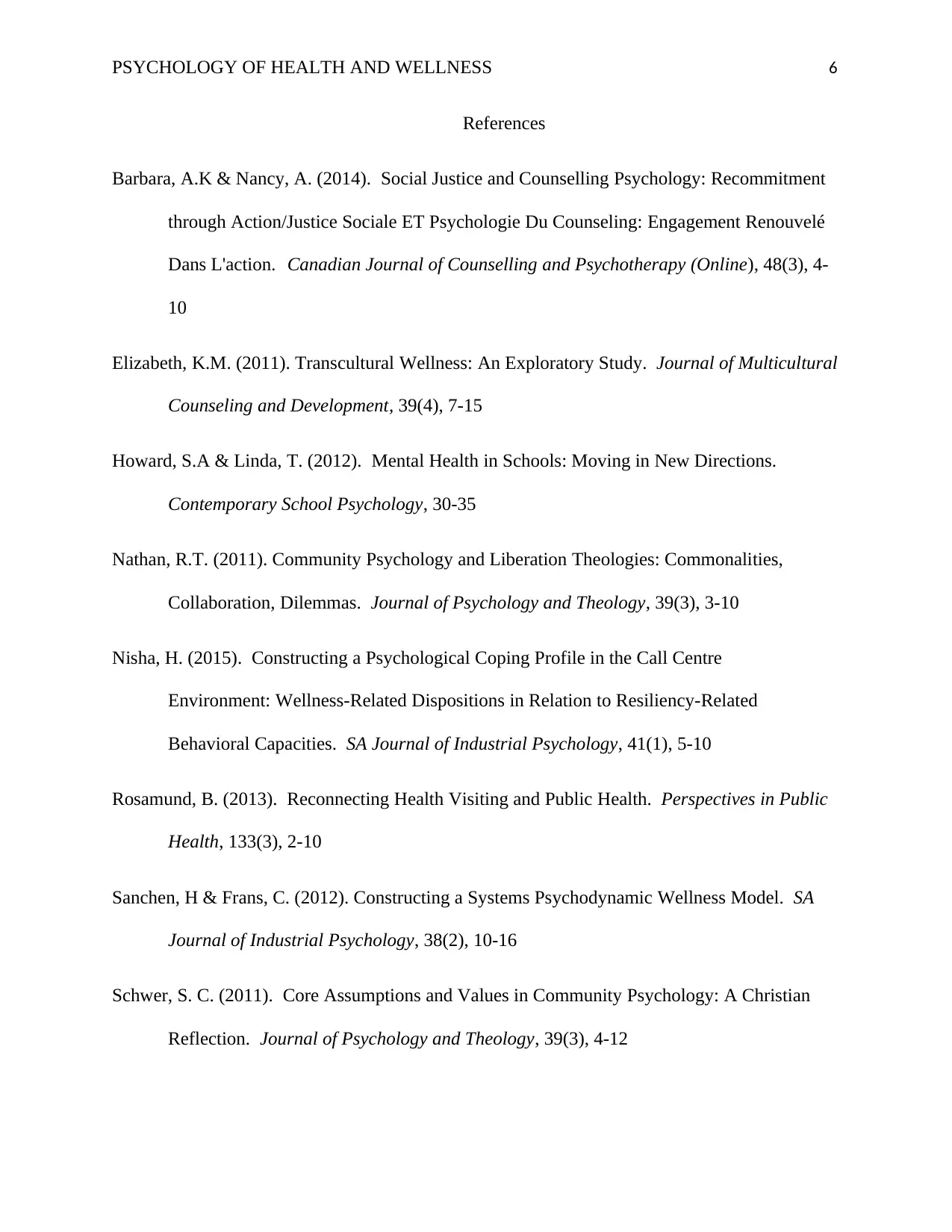
PSYCHOLOGY OF HEALTH AND WELLNESS 6
References
Barbara, A.K & Nancy, A. (2014). Social Justice and Counselling Psychology: Recommitment
through Action/Justice Sociale ET Psychologie Du Counseling: Engagement Renouvelé
Dans L'action. Canadian Journal of Counselling and Psychotherapy (Online), 48(3), 4-
10
Elizabeth, K.M. (2011). Transcultural Wellness: An Exploratory Study. Journal of Multicultural
Counseling and Development, 39(4), 7-15
Howard, S.A & Linda, T. (2012). Mental Health in Schools: Moving in New Directions.
Contemporary School Psychology, 30-35
Nathan, R.T. (2011). Community Psychology and Liberation Theologies: Commonalities,
Collaboration, Dilemmas. Journal of Psychology and Theology, 39(3), 3-10
Nisha, H. (2015). Constructing a Psychological Coping Profile in the Call Centre
Environment: Wellness-Related Dispositions in Relation to Resiliency-Related
Behavioral Capacities. SA Journal of Industrial Psychology, 41(1), 5-10
Rosamund, B. (2013). Reconnecting Health Visiting and Public Health. Perspectives in Public
Health, 133(3), 2-10
Sanchen, H & Frans, C. (2012). Constructing a Systems Psychodynamic Wellness Model. SA
Journal of Industrial Psychology, 38(2), 10-16
Schwer, S. C. (2011). Core Assumptions and Values in Community Psychology: A Christian
Reflection. Journal of Psychology and Theology, 39(3), 4-12
References
Barbara, A.K & Nancy, A. (2014). Social Justice and Counselling Psychology: Recommitment
through Action/Justice Sociale ET Psychologie Du Counseling: Engagement Renouvelé
Dans L'action. Canadian Journal of Counselling and Psychotherapy (Online), 48(3), 4-
10
Elizabeth, K.M. (2011). Transcultural Wellness: An Exploratory Study. Journal of Multicultural
Counseling and Development, 39(4), 7-15
Howard, S.A & Linda, T. (2012). Mental Health in Schools: Moving in New Directions.
Contemporary School Psychology, 30-35
Nathan, R.T. (2011). Community Psychology and Liberation Theologies: Commonalities,
Collaboration, Dilemmas. Journal of Psychology and Theology, 39(3), 3-10
Nisha, H. (2015). Constructing a Psychological Coping Profile in the Call Centre
Environment: Wellness-Related Dispositions in Relation to Resiliency-Related
Behavioral Capacities. SA Journal of Industrial Psychology, 41(1), 5-10
Rosamund, B. (2013). Reconnecting Health Visiting and Public Health. Perspectives in Public
Health, 133(3), 2-10
Sanchen, H & Frans, C. (2012). Constructing a Systems Psychodynamic Wellness Model. SA
Journal of Industrial Psychology, 38(2), 10-16
Schwer, S. C. (2011). Core Assumptions and Values in Community Psychology: A Christian
Reflection. Journal of Psychology and Theology, 39(3), 4-12
⊘ This is a preview!⊘
Do you want full access?
Subscribe today to unlock all pages.

Trusted by 1+ million students worldwide
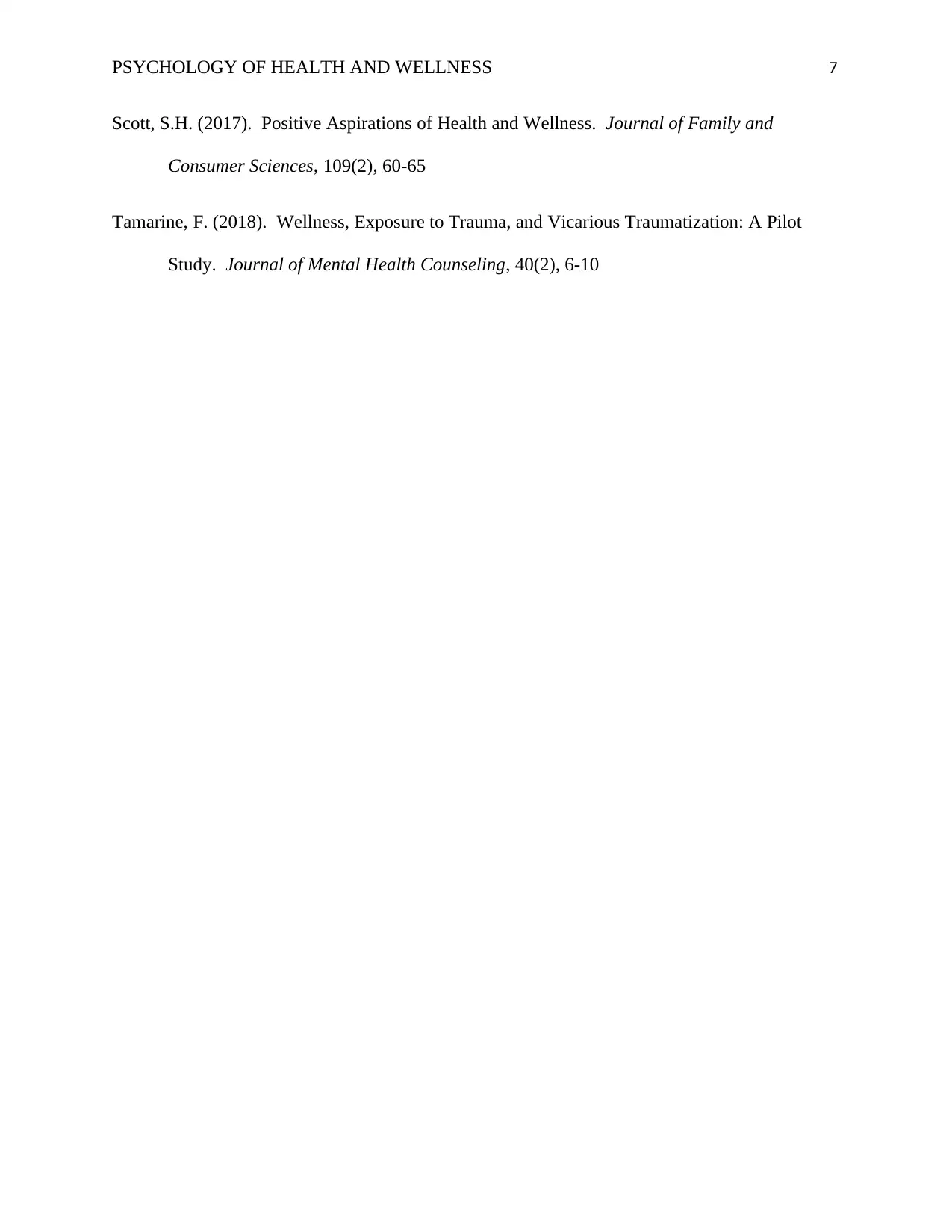
PSYCHOLOGY OF HEALTH AND WELLNESS 7
Scott, S.H. (2017). Positive Aspirations of Health and Wellness. Journal of Family and
Consumer Sciences, 109(2), 60-65
Tamarine, F. (2018). Wellness, Exposure to Trauma, and Vicarious Traumatization: A Pilot
Study. Journal of Mental Health Counseling, 40(2), 6-10
Scott, S.H. (2017). Positive Aspirations of Health and Wellness. Journal of Family and
Consumer Sciences, 109(2), 60-65
Tamarine, F. (2018). Wellness, Exposure to Trauma, and Vicarious Traumatization: A Pilot
Study. Journal of Mental Health Counseling, 40(2), 6-10
1 out of 7
Related Documents
Your All-in-One AI-Powered Toolkit for Academic Success.
+13062052269
info@desklib.com
Available 24*7 on WhatsApp / Email
![[object Object]](/_next/static/media/star-bottom.7253800d.svg)
Unlock your academic potential
Copyright © 2020–2025 A2Z Services. All Rights Reserved. Developed and managed by ZUCOL.





